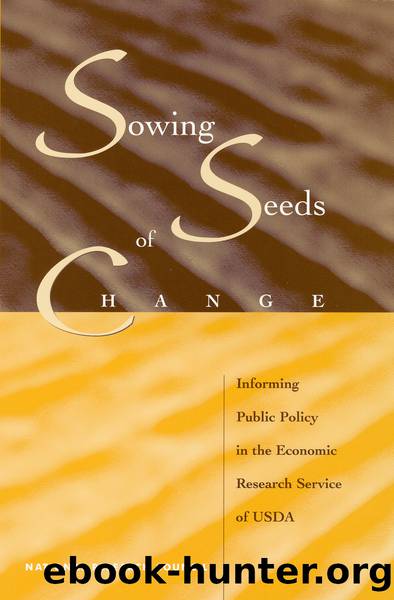Sowing Seeds of Change: Informing Public Policy in the Economic Research Service of USDA by Panel to Study the Research Program of the Economic Research Service

Author:Panel to Study the Research Program of the Economic Research Service
Language: eng
Format: epub
Tags: Behavioral and Social Sciences : Policy, Reviews and Evaluations
Publisher: NATIONAL ACADEMY PRESS
Published: 1999-06-07T00:00:00+00:00
Issues and Problems Facing ERS and USDA
Today ERS faces a series of problems, some persistent dilemmas, and other more recent challenges. ERS can resolve some, but there are other problems that only the secretary of agriculture and the Congress together can address.
Balance Among Products
ERS, and the Bureau of Agricultural Economics (BAE) before it, have produced three overlapping, highly complementary, and often integrated products: (1) intermediate and long-term research, (2) policy analysis, and (3) with the National Agricultural Statistics Service (NASS), the basic information and intelligence base for policy decisions in food, agriculture, and rural resources, both public and private. ERSâs contribution to this third broad category is not basic data collection and its initial processing, which is the role of NASS, but rather secondary data development and related analysis. This ERS product, sometimes called value-added information, involves combining data sets from diverse sources and processing such data through various kinds of analytic models and accounting systems to produce indexes, income and other financial estimates, and different types of projections and forecasts. Perhaps the most visible of these secondary data and analysis products are various ERS indicator series and the many Situation and Outlook (S&O) reports on different dimensions of the U.S. and global food system.
Since the early days of the BAE, it has been clear that there is little or no consistent demand or any associated political support for long-term research. Such research is the necessaryâbut generally unrecognizedâfoundation for high-quality, shorter-term applied analysis of problems and policy questions, and for the development of new or revised secondary data and its analytic structures. The other foundation for good-quality policy analysis is current market intelligence and related institutional knowledge, including policy and political behaviors. It is clear that some secretaries of agriculture and some administrations have valued ERS policy and problem analysis, but others have act. The only consistent demand for ERS products has been the broad public and private usage of basic information and intelligence on food, agriculture, and natural resources, including its packaging as various economic indicators and S&O reports.
This leaves ERS with the difficult problem of finding support for and, with increasingly limited resources, sustaining an appropriate balance among (1) intermediate and long-term research, which has not been supported well in either USDA or the Congress, (2) various type of problem and policy analysis, which is inconsistently supported by the Office of the Secretary and Congress, and (3) the secondary data and analysis function. The recent ERS attempt to reduce resources in S&O activities led to organized political opposition from private-sector clientele, USDA action agencies, and the Congress. It would appear that indicators, S&O intelligence, and related basic information are the only highly visible, broadly valued, and consistently supported ERS products. All three of these products are necessary to the quality of the others and to ERSâs capacity to perform well. But there appears to be little recognition of this complementarity by clientele or by USDA. Both the BAE and ERS have faced this dilemma without the capacity or support to resolve it in any satisfactory fashion.
Download
This site does not store any files on its server. We only index and link to content provided by other sites. Please contact the content providers to delete copyright contents if any and email us, we'll remove relevant links or contents immediately.
The Permaculture Way by Graham Bell(558)
The Permaculture Garden by Graham Bell(488)
People & Permaculture by Looby Macnamara(422)
The Complete Guide to GROWING YOUR HOPS, MALTS, AND BREWING HERBS: EVERYTHING You Need to Know Explained Simply by John Peragine(385)
The New Seed-Starters Handbook by Nancy Bubel & Jean Nick(363)
GMOs Decoded by Sheldon Krimsky(313)
Sowing Seeds of Change: Informing Public Policy in the Economic Research Service of USDA by Panel to Study the Research Program of the Economic Research Service(184)
The Stewardship of the Soil by John H. (John Henry) Worst(24)
Manures and the principles of manuring by Charles Morton Aikman(20)
Diffusion and transfer of knowledge in agriculture by Christian Huyghe Pascal Bergeret Uno Svedin(18)
Right Use of Lime in Soil Improvement by Alva Agee(16)
